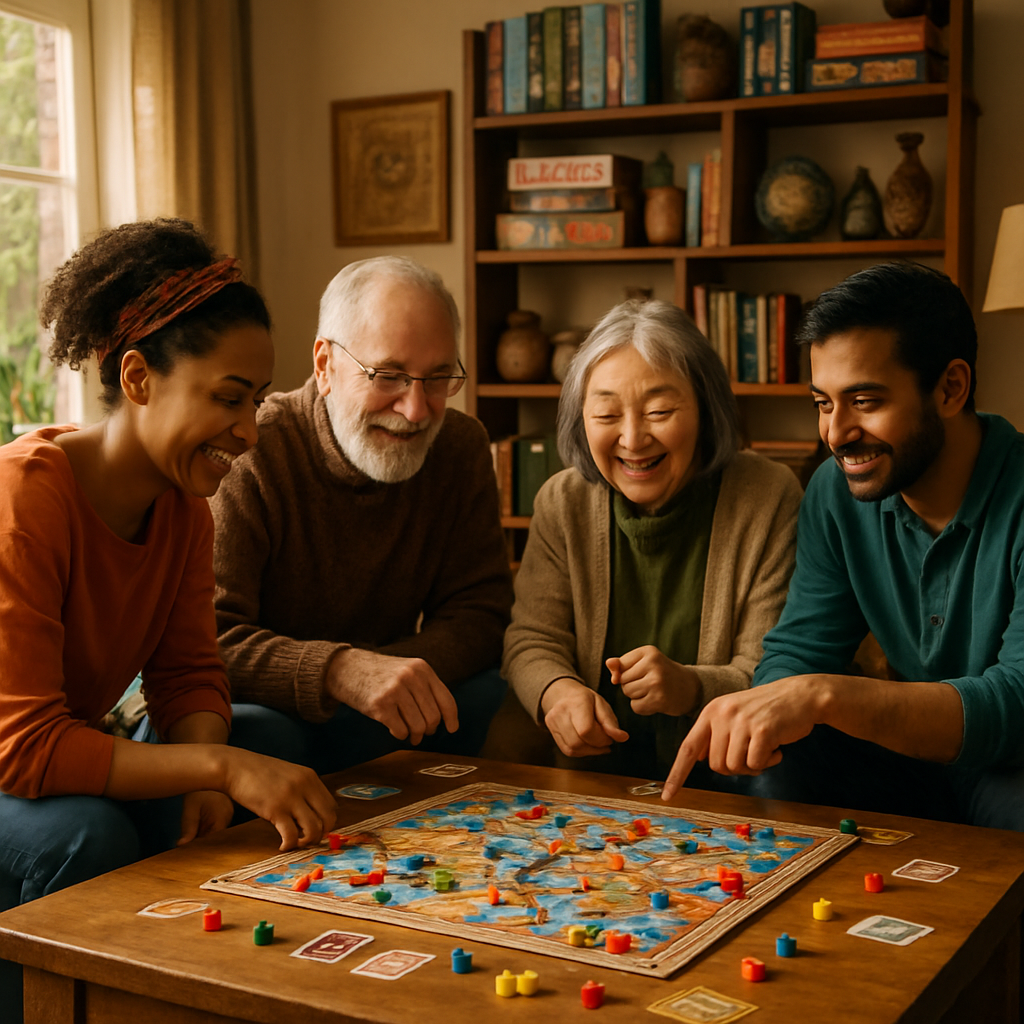Exploring the Unseen Cultural Impact of Board Games Around the World

Beyond rolling dice and moving pieces, board games have silently shaped societies across continents for millennia. These tactile entertainments do far more than pass the time they reflect cultural values, strengthen community bonds, and preserve traditions that might otherwise fade into history. From ancient Egyptian Senet to modern strategy games, board games function as mirrors of the societies that create and play them.
Board games transcend mere entertainment, serving as cultural artifacts that capture the essence of their origins. Each wooden piece, card, or game board carries embedded stories of the people who designed them. The rules themselves often reflect societal structures, religious beliefs, and educational priorities that might not be immediately apparent to casual players.
What makes board games particularly fascinating is how they’ve evolved uniquely in different regions, yet share common threads that connect human experience across geographical boundaries. They represent one of humanity’s oldest social technologies predating written language in some cases yet continue to thrive in our digital age.
The Cultural Fingerprints in Game Design
Board games aren’t created in a vacuum they emerge from specific cultural contexts and carry those influences in their DNA. Take the ancient Chinese game Go (Weiqi), dating back over 2,500 years. Its emphasis on territory control and balanced positioning reflects traditional Chinese philosophical concepts of harmony and equilibrium. The game’s vast board with 361 intersections creates nearly limitless possibilities, mirroring Chinese cultural values of patience, contemplation, and strategic thinking.
Contrast this with Pachisi from India (the ancestor of Parcheesi), which incorporates elements of fate through dice rolls while still rewarding tactical decisions. This balance mirrors Hindu philosophical concepts about destiny and personal agency. The cross-shaped board represents the four directions of the universe in Hindu cosmology, turning a simple race game into a representation of life’s journey.
European games like Chess evolved to reflect feudal power structures with pieces representing specific social roles kings, queens, knights, and pawns. The asymmetrical movement capabilities directly mirror the different privileges and constraints of medieval social classes. When Chess spread to Russia, the bishop piece transformed into a “fool” or jester, reflecting different cultural priorities and social hierarchies.
“I spent months learning Go from an elderly Japanese gentleman in Kyoto,” shares cultural anthropologist Maya Tanaka. “He explained that in Japan, Go isn’t just a game but a way to understand life’s balance. Players learn to sacrifice small battles for greater advantage a concept deeply embedded in Japanese strategic thinking.”
These cultural fingerprints extend to modern games too. German-style board games (often called Eurogames) typically avoid direct conflict and player elimination, focusing instead on resource management and indirect competition. This design philosophy emerged partly from Germany’s post-WWII cultural climate, which discouraged glorifying conflict. Meanwhile, American-style games often embrace direct competition, dramatic narratives, and chance elements reflecting different cultural attitudes toward competition and individualism.
Unexpected Social Functions of Play
Board games serve surprising social purposes beyond entertainment. In many communities, they function as informal educational tools, transmitting knowledge across generations without formal instruction.
The Mancala family of games, played across Africa, Asia, and the Caribbean, teaches mathematical concepts through the movement of seeds or stones. Children learn counting, prediction, and resource management while playing with grandparents. What looks like simple entertainment actually preserves mathematical traditions that predate written numerals in some regions.
In parts of Mongolia and Tibet, the game Shatar (similar to Chess) traditionally served as military training, teaching officers strategic thinking and battlefield assessment. Players weren’t just moving pieces they were rehearsing actual military maneuvers and learning to anticipate enemy responses.
Board games also preserve cultural knowledge during periods of oppression. During colonial rule in various regions, traditional games became vessels for maintaining cultural identity when other expressions were suppressed. The Maori of New Zealand continued playing Mu Torere during British colonization, keeping alive not just the game but the mathematical concepts and oral traditions connected to it.
“My grandmother taught me Yut Nori during Korean New Year celebrations,” explains cultural historian Dr. Jin Park. “Through the game, she shared stories about our ancestors and taught us about Korean values like perseverance and family unity. The game created a space where cultural transmission could happen naturally, without feeling like a lesson.”
Games sometimes function as social equalizers too. In traditional Japanese tea houses, people from different social classes could play Go together one of the few contexts where strict hierarchical boundaries temporarily dissolved. Similarly, in parts of West Africa, Oware games created social spaces where people could interact across age, gender, and status divisions.
Perhaps most surprisingly, board games have served as tools for conflict resolution in some communities. Traditional Inuit games like Inughuaq were sometimes used to settle disputes, allowing conflicts to be resolved through play rather than violence. The competitive yet structured nature of games provided a framework for addressing tensions without escalation.
Board games can also reflect changing social attitudes. The original 1904 version of Monopoly (then called “The Landlord’s Game”) was created by Elizabeth Magie to demonstrate the negative consequences of wealth concentration a progressive political message embedded in gameplay. Today’s version, ironically, celebrates the accumulation of wealth and property that the original game criticized.
Global Exchanges and Modern Transformations
Throughout history, board games have traveled along trade routes, spreading across continents and transforming with each cultural encounter. Chess originated in India around the 6th century as Chaturanga, then migrated to Persia, the Arab world, and finally Europe each culture modifying rules and piece designs to reflect local values and aesthetics.
These cross-cultural exchanges continue today but at unprecedented speed. Japanese games like Shogi find enthusiasts in Brazil; Korean games like Baduk build communities in Canada; German Eurogames transform American game design philosophies. Each crossing creates hybrid forms that wouldn’t exist without cultural exchange.
Digital technology has accelerated these transformations. Online platforms allow players from different continents to compete in real-time, creating global communities around games that were once regionally isolated. A teenager in Singapore can learn an obscure Scandinavian board game through YouTube tutorials, then play against opponents worldwide.
“I run a board game café in Budapest,” says Marta Kovács, “and it’s fascinating to watch how games bridge cultural gaps. We have regular nights where Syrian refugees teach traditional Mancala games to Hungarian locals. Through play, people who might never otherwise interact find common ground and genuine connection.”
Modern board game design increasingly draws conscious inspiration from diverse cultural traditions. Games like Pax Pamir examine Afghan history through strategic gameplay; Spirit Island reverses colonial narratives by casting players as indigenous spirits defending their land against settlers. These designs don’t just borrow aesthetic elements but engage meaningfully with cultural perspectives that mainstream entertainment often overlooks.
The rising popularity of board games globally represents something deeper than just a hobby trend. As digital technology increasingly dominates entertainment, the tactile, face-to-face nature of board games offers something increasingly rare physical presence and direct human connection. Board games create social spaces where people must be fully present with each other, away from screens and notifications.
This explains why board game cafés have exploded in popularity across urban centers worldwide. They offer something paradoxically revolutionary in our hyper-connected age: the chance to disconnect from digital networks and reconnect with people physically present. The cultural impact of this shift extends far beyond gaming itself.
Board games reveal something profound about human societies our need for structured play, our desire to connect across differences, and our ability to encode cultural values into seemingly simple pastimes. From ancient stone boards to modern cardboard creations, these games carry the fingerprints of countless generations who found meaning in moving pieces across patterned surfaces.
The next time you roll dice or place a tile, consider that you’re participating in a cultural tradition older than many religions, connecting you to players across centuries and continents. The game in your hands isn’t just entertainment it’s a living cultural artifact, continuously evolving yet carrying echoes of all the hands that played it before yours.


